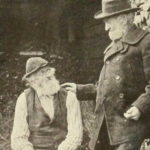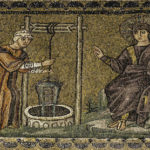We run our website the way we wished the whole internet worked: we provide high quality original content with no ads. We are funded solely by your direct support. Please consider supporting this project.

The Old Testament Is NOT on the Same Plane as the New Testament
Paul taught that unbelievers are blinded by “the god of this age” when they read the OT such that “their minds are made dull” and a “veil covers their hearts…when the old covenant is read” (2 Cor. 4:4; 3:14-15). This is why they are unable to see “the light of the knowledge of God’s glory displayed in the face of Christ” (2 Cor. 4:6). The implication of Paul’s teaching is that the ultimate revelation of the OT, which can only be seen when a person “turns to the Lord” and “the veil is taken away” (2 Cor. 3:16), is the divine glory that is revealed in Christ.
This demonstrates that, from a distinctly Christian perspective, the revelation of God in Christ can’t be said to add to the revelation given in the OT, as though these two sources of revelation were on the same plane. Rather, when we turn to the Lord and have the veil removed, we are empowered to discern that the revelation of “God’s glory displayed in the face of Christ” actually constitutes the true revelatory content of the OT. Hence, I don’t believe it would be going too far to say that, not only are these “two sources” of revelation not on the same plane, but when the former is read in light of the latter, we can no longer legitimately speak of “two” distinct sources. In the words of the twelfth-century Augustinian, Hugh of St. Victor, when read in light of Christ, we can see that “the whole of scripture is one book, and that one book is Christ.”
This isn’t to in any way depreciate the indispensability of the OT. It is utterly impossible to understand either Jesus or the NT except against the backdrop of the OT. Those who have attempted to divorce Jesus and the Gospel from the OT have ended up with nothing that remotely resembles the real Jesus and the real Gospel. Yet, as indispensible as the OT is for providing the framework within which Jesus and the kingdom movement he launched must be understood, it is evident that the NT generally doesn’t see it as providing a revelation of God that is distinct from Jesus.
As a matter of fact, there are several points in the NT when the unprecedented authority of Jesus to reveal God is stressed to a degree that it almost seems to eclipse the OT altogether. For example, at one point Jesus made the astounding claim that “[a]ll things have been committed to me by my Father. No one knows the Son except the Father, and no one knows the Father except the Son and those to whom the Son chooses to reveal him” (Mt 11:27). It seems to me we have to interpret this teaching somewhat hyperbolically since a literal interpretation of “no one” would imply that none of the authors of the OT knew God, a conclusion that runs up against Jesus’ own use of the OT.
At the same time, it seems undeniable that Jesus was at least claiming that his knowledge of the Father, and his revelation of the Father, dwarfs in significance all previous revelations. While God may have committed small and imperfect disclosures of himself to previous spokespeople, he committed “all things” to Jesus, including the sole capacity to fully and perfectly make him known.
This is illustrated by the encounter Jesus had with Moses and Elijah. According to Church tradition and many contemporary scholars, a similar point may be discerned in the synoptic accounts of Jesus’ transfiguration. While in prayer, Peter, John and James beheld Jesus’ “glory” and then witnessed Moses and Elijah talking to Jesus about “his departure which he was about to bring to fulfillment at Jerusalem” (Lk 9:29-32). As Peter tried to persuade Jesus to let them make “three shelters” for him and his two companions, a cloud enveloped them and a voice from heaven said; “This is my Son, whom I have chosen; listen to him.” When the cloud lifted, “they found that Jesus was alone” (33-36).
While there are a number of things going on in this fascinating passage, it seems that a central part of its message is that, while the law (Moses) and the prophets (Elijah) testify to Jesus, Jesus’ own disciples are to take their marching orders directly from him. This explains why Moses and Elijah talk to Jesus about the fulfillment of his mission in this vision. Their significance is centered on him. It also arguably explains why the cloud appeared as Peter was lobbying to build a permanent place for Moses and Elijah alongside Jesus. The law and the prophets are fulfilled in Jesus but are not to rival his authority.
This point is further stressed in the fact that the radiance of Moses and Elijah is outshined and outlasted by the radiance of Jesus, as well as by the fact that Moses and Elijah disappear while Jesus remains. And, most importantly, the unrivaled supremacy of Jesus over and against the OT is clearly driven home when, just after Moses and Elijah disappear, the three disciples stand before Jesus and hear a voice from heaven telling them to “listen to him.” If the law and the prophets have anything to say to followers of Jesus, this vision suggests, it is only because they point toward, and agree with, Jesus. When anything in the law or prophets does not agree with Jesus, however, the implication is that we should keep our eyes fixed on Jesus.
The OT isn’t viewed by Paul and other NT writers as revealing truths alongside the revelation of God we find in Jesus. It’s rather viewed as containing the same revelation – the same gospel message – but in an inchoate form. Hence, it is as a vague “shadow” that points to the reality, which is Jesus Christ. In the words of Graeme Goldsworthy, “Jesus and the apostles regarded the whole of the Old Testament as testimony to the Christ; it is all about Jesus” (emphasis original). For them, “there is no dimension of the Old Testament message that does not in some way foreshadow Christ.”
Image by Jackal1 via Flickr.
Category: General
Tags: Bible, Cruciform Theology, Jesus, New Testament, Old Testament
Topics: Biblical Interpretation
Related Reading

Conflicting Pictures of God
In my ongoing reflections on the ReKnew Manifesto, I’ve spent the last two posts (here and here) arguing that nothing is more important in our life than our mental images of God. If so, then the all-important question is: what authority do we trust to tell us what God is like? To most evangelicals, the…

Uncrossed
Did any of you catch SNL this weekend? They did a parody of Tarantino’s DJango Unchained called DJesus Uncrossed. Many were deeply offended by the depiction of Jesus in this, but David R. Henson blogged about how this skit revealed what we’ve already been doing for quite a while as a culture. In his blog…

Overview of Crucifixion of the Warrior God
Greg reviewed the content of his new book, Crucifixion of the Warrior God, as a part of the Woodland Hills Church Covenant Partner gathering on March 5, 2017. If you want a fairly succinct synopsis of the thesis of his book, look no further. Ten years ago, Greg set out to write a book justifying the…

Podcast: Where Does Forgiveness Fit in a Cruciform Theology?
Greg offers looks at forgiveness in a realm of natural consequences. http://traffic.libsyn.com/askgregboyd/Episode_0298.mp3

Jesus and the “Favored Nation”
Nationalism lies at the heart of the Old Testament narrative. This concept is intimately wrapped up with the law-oriented covenant God made with the Israelites at Mount Sinai, for at the heart of this covenant is the promise that obedience would bring national security while disobedience would bring national disaster (Deut. 27-28). What we shall…

